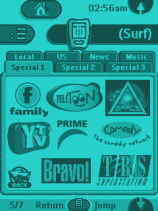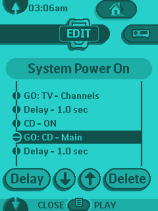|
...Continued from Page 16.

An example of a tabbed layout. |
Scrolling through panels with the basic factory configuration is quick enough at about one second between each. But when you get into complex, customized panels the number swells to two seconds or more - which, to some, is just too slow. A slightly quicker option is to create "tabs" on the device screen in ProntoEdit that do nothing but jump to a particular panel. Since the remote doesn't have to format the entire screen in memory, then animate it, that two-second scroll is cut back down to one second. I personally feel the scroll arrows are too small and placed overly close to the edge of the screen, but with the tab navigation system that's less of a problem. Happily, the remote does not need to redraw the screen when it wakes up from sleep mode - it's instantly displayed.
IR strength is incredible. You simply can't get much better than the Pronto. The four emitters on the front of the unit blast out enough infrared that you don't need to aim the remote anywhere close to what you're controlling. To paraphrase a popular marketing slogan, "just press it". Since the Pronto TS-1000 is the remote that spawned the creation of our internationally ignored "Menacing Thick Fluffy Blanket" (MTFB) test, we naturally assumed the TSU2000 would do equally as well. It passed level one like there was no obstruction whatsoever. Level two, two layers, also posed little challenge, although some added restrictions on the vertical plane were evident. Level three (new) was much more of a challenge - signals usually got through, but not consistently.
Marantz RC5000i
Since Marantz is actually owned by Philips, they also sell a version of the Pronto known as the RC5000 or, more comparable to the TSU2000, the RC5000i. Unfortunately, it seems that some friendly rivalry has generated specific features that are proprietary to one remote or another. For instance, although the hardware is identical between the TSU2000 and RC5000i, the RC5000i does not feature the Pronto's built-in code database, timer nor custom "beep" functions. On the other hand, the RC5000 series has its own exclusive features that the TSU2000 does not.
First is "jumps in macros". As opposed to the Pronto's method of selecting a single panel to jump to at the end of a macro, the RC5000 can jump to any panel while a single macro is running - jumps become part of the action list. This can be used to create crude animations or notify the user what is happening while a long macro runs, but also has a downside in that aliases to that button will also execute the assigned jumps.

An example RC5000i macro with multiple "GO" jumps. |
Next is "panel memory". While all Pronto/RC5000 models return to the exact panel that was last displayed for a section or device, there was no way to add this same function to a user button. For instance, many users with IR-controlled lighting systems would like a button that returns to whatever page they came from. The RC5000 can now replicate that feature, forwards or backwards up to 5 panels.
Yet another is "custom scroll arrows". Although minor, it's possible on the RC5000 to assign customized up and down scroll arrows, just as it's possible on all models to assign a custom icon for the "Home" button. A questionable proprietary feature on the RC5000 - one that really makes you think "why did they do that?" - is the ability to disable the Device and Macro menus. It doesn't free up any screen real estate as they still sit there, occupying space.
| 
